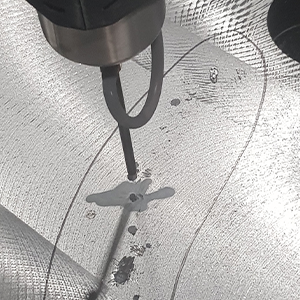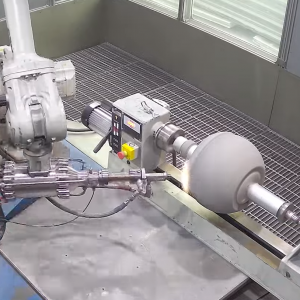
Casting Repair: 3D Measuring Table Repaired with Cold Spray
Titomic’s Cold Spray Technology streamlines casting repair, ensuring fast, precise, and undistorted results for your high-stakes industrial components.
Repairing and restoring metal components can be complex and time consuming – and the right technique can make all the difference.
For decades, engine refurbishment has been limited by traditional methods such as welding, and coating methods that are slow, dangerous, and difficult.
Cold spray offers an alternative. A process which deposits a vast range of metals with exception bond strength at speed. With cold spray, you can put down dense layers of metal to repair and resurface parts without heat and without damage.
Produce coatings and repairs with fine-grained microstructures and minimal porosity.
Cold spray also deposits extremely thick coatings, up to 50mm thick to restore and refurbish critical parts.
Use a wider variety of metal alloys and open new possibilities for restoring components previously considered to be beyond repair.
Fuse nickel onto cast iron, aluminium onto steel, and so much more.
Repair corrosion and provide long-lasting protection, such as in marine applications where grit is used to blast away corrosion and apply corrosion-resistant aluminium to steel structures – without the need for disassembly.
Repair delicate or temperature-sensitive components, such as cast iron casings, with minimal heat input, reducing the risk of cracking, annealing, or other damage.
Repair obsolete or expensive components in hours – rather than waiting months for replacement parts.
While our article What is cold spray? covers this revolutionary method in more detail, here’s a brief snapshot:
Cold spray is a process in which metal powders are accelerated to high speeds using compressed gas, and then impacted onto a substrate. This forces the particles to bond to the substrate, forming a dense, solid coating.
Often when key components on heavy vehicles are damaged, they’re scrapped or replaced. This is a costly yet entirely avoidable expense.
Learn how our cold spray technology systems make it easy and cost-effective to repair and restore parts – so your operations can keep on moving.
Titomic cold spray was evaluated on the rebuild and long-life maintenance of a large-scale diesel engine. With numerous repairs made with cold spray, the engine was seen to be operating well after 24,000 hours of operation, with cold spray proving to be a competitive repair solution.
There’s a reason why welding has been a staple of metal repair and restoration for decades. By heating metal parts until sections of them become pliable or molten, it’s easy to mould them together – as well as make joints more precise and controlled. And because welding can join metal parts of any thickness, it’s a versatile way to build a wide range of metal components.
But there’s a catch: welding a large area to repair geometry or surface imperfections can introduce significant heat. This threatens the metal’s grain structure, potentially causing warping, cracking, or heat distortion.













See how our low-pressure cold spray systems rapidly restores metal parts, to drastically reduce repair and maintenance costs.
Learn what other industry leaders have achieved with our TKF Additive Manufacturing System.

Titomic’s Cold Spray Technology streamlines casting repair, ensuring fast, precise, and undistorted results for your high-stakes industrial components.

Learn how Titomic’s D523 low-pressure cold spray system was used to quickly repair a classic car with no heat. The no-heat process does what welding, putty, and epoxies couldn’t for 20 years. Now, this vintage race car is back on the track, ready to take its driver toward the podium.
with us today to see how you can leverage cold spray to save time and costs.
Often when key components on heavy vehicles are damaged, they’re scrapped or replaced. This is a costly yet entirely avoidable expense.
Learn how our cold spray technology systems make it easy and cost-effective to repair and restore parts – so your operations can keep on moving.
Often when key components on heavy vehicles are damaged, they’re scrapped or replaced. This is a costly yet entirely avoidable expense.
Learn how our cold spray technology systems make it easy and cost-effective to repair and restore parts – so your operations can keep on moving.